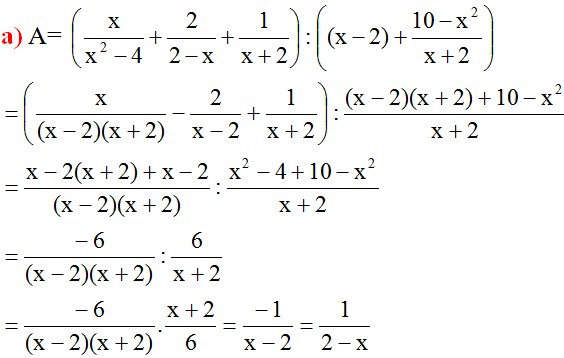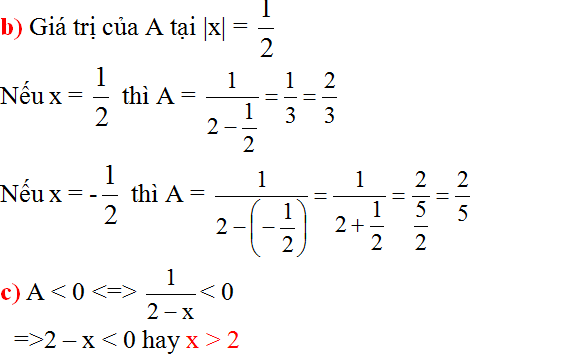Hãy nhập câu hỏi của bạn vào đây, nếu là tài khoản VIP, bạn sẽ được ưu tiên trả lời.

Lời giải của bạn Nhật Linh đúng rồi, tuy nhiên cần thêm điều kiện để A có nghĩa: \(x\ne\pm2\)

\(ĐKXĐ:x\ne-3;2\)
\(\frac{x+2}{x+3}-\frac{5}{x^2+x-6}-\frac{1}{x-2}=\frac{x+2}{x+3}-\frac{5}{\left(x+3\right)\left(x+2\right)}-\frac{1}{x-2}\)
\(=\frac{x^2+4x+4}{\left(x+3\right)\left(x+2\right)}-\frac{5}{\left(x+3\right)\left(x+2\right)}-\frac{x+3}{\left(x+2\right)\left(x+3\right)}\)
\(=\frac{x^2+4x+4-5-x-3}{\left(x+2\right)\left(x+3\right)}=\frac{x^2+3x-4}{\left(x+3\right)\left(x+2\right)}=\frac{\left(x+4\right)\left(x-1\right)}{\left(x+3\right)\left(x+2\right)}\)
\(x^2-9=0\Leftrightarrow x=3\left(vì:x\ne-3\right)\)
\(\Rightarrow P=\frac{7}{15}\)
\(P\inℤ\Leftrightarrow x^2+3x-4⋮x^2+5x+6\Leftrightarrow2x+10⋮x^2+5x+6\Leftrightarrow12⋮x^2+5xx+6\)
\(................\left(dễ\right)\)
P/s: shitbo sai rồi nha bạn!Nếu không tin thì thay x = 3 vào P ban đầu và giá trị P sau khi rút gọn sẽ thấy sự khác biệt =)
ĐK: \(x\ne-3;x\ne2\)
a) \(P=\frac{x+2}{x+3}-\frac{5}{x^2+x-6}-\frac{1}{x-2}\)
\(=\frac{x^2-4}{\left(x+3\right)\left(x-2\right)}-\frac{5}{\left(x-2\right)\left(x+3\right)}-\frac{x+3}{\left(x-2\right)\left(x+3\right)}\)
\(=\frac{x^2-x-12}{\left(x+3\right)\left(x-2\right)}=\frac{\left(x-4\right)\left(x+3\right)}{\left(x+3\right)\left(x-2\right)}=\frac{x-4}{x-2}\)
b) \(x^2-9=0\Leftrightarrow x^2=9\Leftrightarrow x=\pm3\)
Thay vào điều kiện,tìm loại x = -3 .Tìm được x =3
Ta có: \(P=\frac{x-4}{x-2}=\frac{3-4}{3-2}=-1\)
c)Ta có: \(P=\frac{x-4}{x-2}=\frac{x-2-2}{x-2}=1-\frac{2}{x-2}\)
Để P có giá trị nguyên thì \(\frac{2}{x-2}\) nguyên hay \(x-2\inƯ\left(2\right)=\left\{\pm1;\pm2\right\}\)
Suy ra \(x=\left\{0;1;3;4\right\}\)

để A xác định
\(\Rightarrow\hept{\begin{cases}x+2\ne0\\x-2\ne0\\x^2\ne4\end{cases}}\Rightarrow x\ne\pm2\)
\(A=\frac{4}{x+2}+\frac{3}{x-2}-\frac{5x-6}{x^2-4}\)
\(A=\frac{4.x-8}{\left(x+2\right).\left(x-2\right)}+\frac{3.x+6}{\left(x-2\right).\left(x+2\right)}-\frac{5x-6}{\left(x-2\right).\left(x+2\right)}\)
\(A=\frac{4x-8+3x+6-5x+6}{\left(x+2\right).\left(x-2\right)}=\frac{2.\left(x+2\right)}{\left(x+2\right).\left(x-2\right)}=\frac{2}{x-2}\)
\(\frac{4}{x+2}+\frac{3}{x-2}-\frac{5x-6}{x^2-4}=\frac{4}{x+2}+\frac{3}{x-2}-\frac{5x-6}{\left(x+2\right)\left(x-2\right)}\)
\(=\frac{4x-8}{\left(x+2\right)\left(x-2\right)}+\frac{3x+4}{\left(x-2\right)\left(x+2\right)}-\frac{5x-6}{\left(x-2\right)\left(x+2\right)}=\frac{4x-8+3x+4-5x+6}{\left(x+2\right)\left(x-2\right)}\)
\(=\frac{2x+2}{\left(x+2\right)\left(x-2\right)}=\frac{2x+2}{x^2-4}\)
C, \(x=4\Rightarrow A=\frac{2x+2}{x^2-4}=\frac{-6}{12}=\frac{-1}{2}\)
d, \(A\inℤ\Leftrightarrow2x+2⋮x^2-4\Leftrightarrow2x^2+2x-2x^2+8⋮x^2-4\Leftrightarrow2x+8⋮x^2-4\)
\(\Leftrightarrow2x^2+8x⋮x^2-4\Leftrightarrow16⋮x^2-4\)
\(x^2-4\inℕ\)
\(\Rightarrow x^2\in\left\{0;4;12\right\}\)
Thử lại thì 12 ko là số chính phương vậy x=0 hoặc x=2 thỏa mãn
mk học lớp 6 mong mn thông cảm nếu có sai sót

a) \(ĐKXĐ:\hept{\begin{cases}x\ne0\\x\ne-5\end{cases}}\)
\(P=\frac{x^2}{5x+25}+\frac{2x-10}{x}+\frac{50+5x}{x^2+5x}\)\(=\frac{x^2}{5\left(x+5\right)}+\frac{2\left(x-5\right)}{x}+\frac{5\left(x+10\right)}{x\left(x+5\right)}\)
\(=\frac{x^3}{5x\left(x+5\right)}+\frac{10\left(x-5\right)\left(x+5\right)}{5x\left(x+5\right)}+\frac{25\left(x+10\right)}{5x\left(x+5\right)}\)
\(=\frac{x^3+10\left(x-5\right)\left(x+5\right)+25\left(x+10\right)}{5x\left(x+5\right)}=\frac{x^3+10\left(x^2-25\right)+25x+250}{5x\left(x+5\right)}\)
\(=\frac{x^3+10x^2-250+25x+250}{5x\left(x+5\right)}=\frac{x^3+10x^2+25x}{5x\left(x+5\right)}\)\(=\frac{x\left(x^2+10x+25\right)}{5x\left(x+5\right)}\)\(=\frac{\left(x+5\right)^2}{5\left(x+5\right)}=\frac{x+5}{5}\)
b) \(x^2-3x=0\)\(\Leftrightarrow x\left(x-3\right)=0\)\(\Leftrightarrow\orbr{\begin{cases}x=0\\x-3=0\end{cases}}\Leftrightarrow\orbr{\begin{cases}x=0\\x=3\end{cases}}\)
So sánh với ĐKXĐ, ta thấy \(x=0\)không thoả mãn
Thay \(x=3\)vào biểu thức ta được: \(P=\frac{3+5}{5}=\frac{8}{5}\)
c) Để \(P=-4\)thì \(\frac{x+5}{5}=-4\)\(\Leftrightarrow x+5=-20\)\(\Leftrightarrow x=-25\)( thoả mãn ĐKXĐ )
Vậy \(P=-4\)\(\Leftrightarrow x=-25\)
d) Để \(P\ge0\)thì \(\frac{x+5}{5}\ge0\)\(\Leftrightarrow x+5\ge0\)( vì \(5>0\))\(\Leftrightarrow x\ge-5\)
So sánh với ĐKXĐ, ta thấy x phải thoả mãn \(x>-5\)và \(x\ne0\)
Vậy \(P\ge0\)\(\Leftrightarrow\)\(x>-5\)và \(x\ne0\)

a: \(\dfrac{2x-3}{35}+\dfrac{x\left(x-2\right)}{7}\le\dfrac{x^2}{7}-\dfrac{2x-3}{5}\)
\(\Leftrightarrow2x-3+5x\left(x-2\right)\le5x^2-7\left(2x-3\right)\)
\(\Leftrightarrow2x-3+5x^2-10x< =5x^2-14x+21\)
=>-8x-3<=-14x+21
=>6x<=24
hay x<=4
b: \(\dfrac{6x+1}{18}+\dfrac{x+3}{12}>=\dfrac{5x+3}{6}+\dfrac{12-5x}{9}\)
=>2(6x+1)+3(x+3)>=6(5x+3)+4(12-5x)
=>12x+2+3x+9>=30x+18+48-20x
=>15x+11>=10x+66
=>5x>=55
hay x>=11

a) P xác định \(\Leftrightarrow\hept{\begin{cases}2x+10\ne0\\x\ne0\\2x\left(x+5\right)\ne0\end{cases}\Leftrightarrow x\ne\left\{-5;0\right\}}\)
b) \(P=\frac{x^2+2x}{2x+10}+\frac{x-5}{x}+\frac{50-5x}{2x\left(x+5\right)}\)
\(P=\frac{x^2\left(x+2\right)}{2x\left(x+5\right)}+\frac{2\left(x-5\right)\left(x+5\right)}{2x\left(x+5\right)}+\frac{5\left(10-x\right)}{2x\left(x+5\right)}\)
\(P=\frac{x^3+2x^2+2x^2-50+50-5x}{2x\left(x+5\right)}\)
\(P=\frac{x^3+4x^2-5x}{2x\left(x+5\right)}\)
\(P=\frac{x^3+5x^2-x^2-5x}{2x\left(x+5\right)}\)
\(P=\frac{x^2\left(x+5\right)-x\left(x+5\right)}{2x\left(x+5\right)}\)
\(P=\frac{\left(x+5\right)\left(x^2-x\right)}{2x\left(x+5\right)}\)
\(P=\frac{x\left(x-1\right)}{2x}\)
\(P=\frac{x-1}{2}\)
c) Để P = 0 thì \(x-1=0\Leftrightarrow x=1\)( thỏa mãn ĐKXĐ )
Để P = 1/4 thì \(\frac{x-1}{2}=\frac{1}{4}\)
\(\Leftrightarrow4\left(x-1\right)=2\)
\(\Leftrightarrow4x-4=2\)
\(\Leftrightarrow4x=6\)
\(\Leftrightarrow x=\frac{3}{2}\)( thỏa mãn ĐKXĐ )
d) Để P > 0 thì \(\frac{x-1}{2}>0\)
Mà 2 > 0, do đó để P > 0 thì \(x-1>0\Leftrightarrow x>1\)
Để P < 0 thì \(\frac{x-1}{2}< 0\)
Mà 2 > 0, do đó để P < 0 thì \(x-1< 0\Leftrightarrow x< 1\)



Trả lời
a,- Rút gọn A như sau:
A= \(\dfrac{4}{x+2}+\dfrac{2}{x-2}-\dfrac{5x-6}{x^2-4}\)
A= \(\dfrac{4}{x+2}+\dfrac{2}{x-2}-\dfrac{5x-6}{\left(x-2\right)\left(x+2\right)}\)
A= \(\text{}\text{}\dfrac{4\left(x-2\right)}{\left(x-2\right)\left(x+2\right)}+\dfrac{2\left(x+2\right)}{\left(x-2\right)\left(x+2\right)}-\dfrac{5x-6}{\left(x-2\right)\left(x+2\right)}\)
A= \(\dfrac{4x-8}{\left(x-2\right)\left(x+2\right)}+\dfrac{2x+4}{\left(x-2\right)\left(x+2\right)}-\dfrac{5x-6}{\left(x-2\right)\left(x+2\right)}\)
A= \(\dfrac{4x-8+2x+4-5x+6}{\left(x-2\right)\left(x+2\right)}\)
A= \(\dfrac{x-2}{\left(x-2\right)\left(x+2\right)}\) A= \(\dfrac{1}{x+2}\) -Thay x = \(\dfrac{7}{3}\)vào biểu thức A ta có: A= \(\dfrac{1}{\dfrac{7}{3}+2}\) A=\(\dfrac{3}{13}\) Vậy khi x= \(\dfrac{7}{3}\)thì A có giá trị bằng \(\dfrac{3}{13}\)